Physical Address
304 North Cardinal St.
Dorchester Center, MA 02124
Chronic venous insufficiency, which must be semantically distinguished from venous disease or disorder, may be defined as relative impedance of venous flow back to the heart and may be responsible for clinical consequences. When this occurs in the lower extremities, the normal reabsorption of perivascular fluids by osmotic and pressure gradients is impaired, resulting in accumulation of perivascular and lymphatic fluid. This leads to edema and impaired oxygenation of surrounding tissue ( Figs 2.1 and 2.2 ). This disruption of the normal vascular and lymphatic flow of the lower extremities may result in pain, cramping (especially at night), restlessness, pigmentary changes, dermatitis and ulceration ( Fig. 2.3 ). The association of abnormal venous flow with various signs and symptoms has been noted for centuries: first by Hippocrates in the fourth century bc and by Wiseman in England in 1676. It has been estimated that chronic venous insufficiency will develop in almost 50% of patients with major varicose veins.
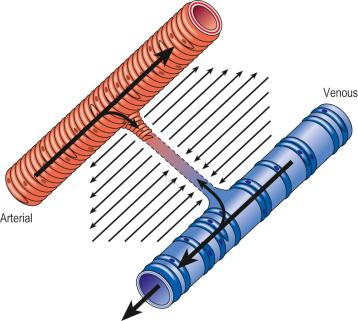
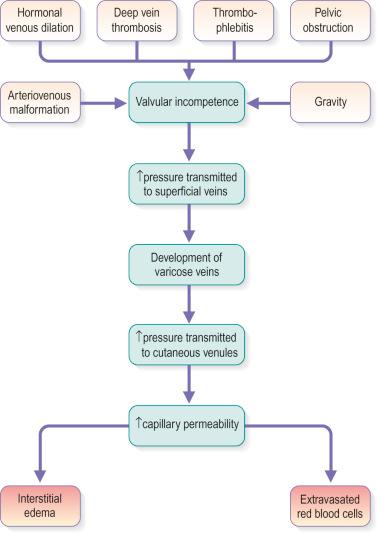
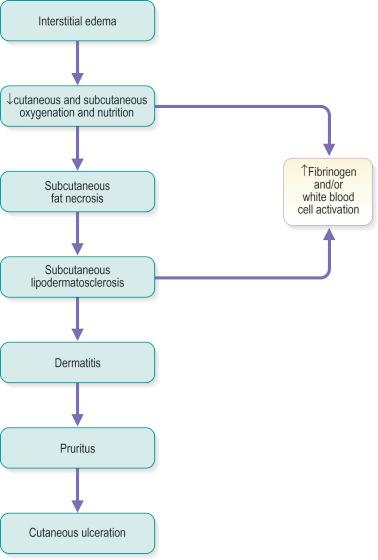
Several alterations of normal venous flow cause venous hypertension. Such hypertension in the lower extremities is usually caused by a loss or disruption of the normal one-way valvular system. This may occur because of deep vein thrombosis (DVT), thrombophlebitis or a dilation of veins from other causes. When perforating vein valvular function becomes incompetent, there may be shunting of blood flow from the deep to the superficial venous system through the incompetent perforating veins, with resultant adverse sequelae. The superficial veins respond by dilating to accommodate the increased blood flow, which produces superficial valvular incompetence leading to the development of varicosities. In addition, with muscular movement in the lower limbs, the high venous pressure normally occurring within the calf is transmitted straight to the superficial veins and subcutaneous tissues. Venous pressure in the cuticular venules may greatly exceed the normal value of 100 mmHg in the erect position. This causes venular dilation over the whole area, resulting in capillary dilation, increased permeability and increase in the subcutaneous capillary bed. This is manifested as telangiectasia and venectasia ( Fig. 2.4 ). Venous hypertension has also been demonstrated to destroy the venous valves that are present in the subcuticular vascular system. This destruction promotes persistent and progressive changes in the venous drainage system of the skin and subcutaneous tissues. The greater the degree of venous hypertension, the greater the risk of venous ulcer development. Fortunately, both sclerotherapy and surgical treatment are capable of normalizing abnormal venous hypertension.
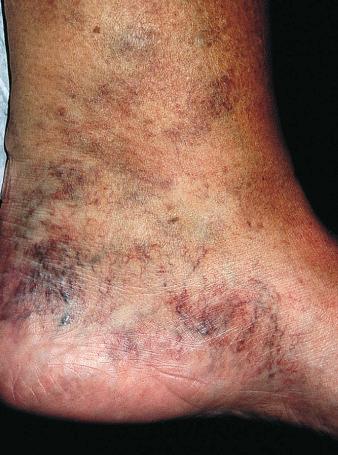
Venous hypertension and subsequent insufficiency may also derive from venous obstruction, either at lower limb level or at iliocaval level, usually associated with reflux.
The molecular mechanisms involved in leukocyte adhesion and activation in chronic venous disease (CVD) are beginning to be elucidated. Circulating leukocytes and vascular endothelial cells express membrane adhesion molecules. For example, binding of L-selectin on the leukocyte surface to E-selectin on endothelial cells may be involved in leukocyte ‘rolling’ along the endothelial surface ( Fig. 2.5A ). Then, when leukocytes are activated, they shed L-selectin into the plasma and express molecules of the integrin family, including CD11b, which binds firmly to intercellular adhesion molecule-1 (ICAM-1). Integrin binding can promote firm adhesion of leukocytes, the starting point for their degranulation and migration through the endothelium.
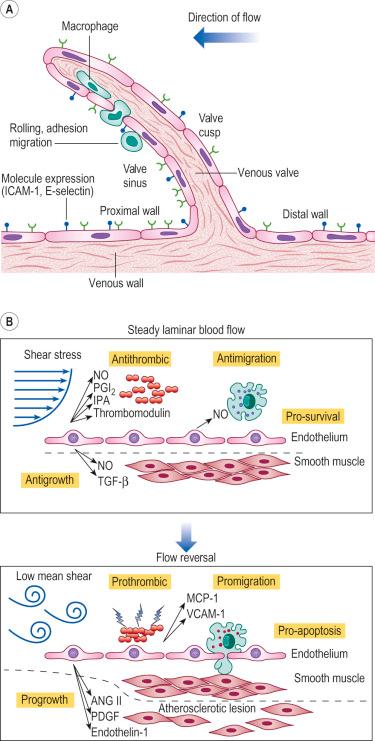
Several studies have looked at markers of leukocyte and endothelial adhesion and activation in CVD. After venous hypertension was induced by standing for 30 minutes, levels of L-selectin and integrin CD11b on circulating neutrophils and monocytes in patients with CVD were found to decrease, reflecting the trapping of these cells in the microcirculation. At the same time, plasma levels of soluble L-selectin increased, reflecting the shedding of these molecules from leukocyte surfaces during leukocyte–endothelial adhesion. Similarly, basal plasma levels of the adhesion molecules ICAM-1, endothelial leukocyte adhesion molecule-1 (ELAM-1), and vascular cell adhesion molecule-1 (VCAM-1) were higher in patients with CVD than controls and increased significantly in response to venous hypertension provoked by standing. Baseline levels of plasma von Willebrand factor, a marker for endothelial cell damage, were also higher in patients with lipodermatosclerosis than in those without skin changes. Lactoferrin and neutrophil elastase are enzymes released from neutrophil granules. Plasma levels of these molecules are therefore markers of neutrophil activation, and both were found to be higher in patients with CVD than in age- and sex-matched controls.
In most of these studies, prolonged standing induced venous hypertension. However, in patients with chronic venous insufficiency, increases in plasma levels of ICAM-1 and VCAM-1 can be induced by walking, presumably in response to hydrodynamic pressure increases generated by the musculovenous pump being transmitted to subcutaneous and cutaneous small vessels through incompetent perforating veins.
In addition to local factors operating in relation to venous hypertension, patients with CVD have a tendency for systemically elevated leukocyte adhesion. Venous hypertension in the upper limb (where the local vessels and tissues are presumably normal) produced by means of a pressure cuff causes greater leukocyte accumulation in patients with venous leg ulcers than in normal subjects. Evidence has been found for an activation factor in the plasma of patients with CVD. Plasma obtained from patients with CVD induced greater degrees of activation as shown by production of oxygen free radical production and pseudopod formation in healthy granulocytes than did plasma taken from normal subjects. Also, there was a trend toward more activation in more severe cases of chronic venous insufficiency. The nature of the plasma factor responsible for leukocyte adhesion and activation is presently unknown.
There has also been progress in linking the chronic inflammatory state seen in patients with CVD with the specific skin changes typical of the condition. In lipodermatosclerosis, the skin capillaries become elongated and tortuous, giving the appearance in histologic sections of elevated capillary density. In advanced skin disease, especially in the ulcerative stages, the capillaries may take on a glomerular appearance, and it seems clear that substantial proliferation of the capillary endothelium occurs. Several factors could contribute to endothelial proliferation, but vascular endothelial growth factor (VEGF) is an obvious candidate. VEGF is known to be involved in inflammatory and healing processes in the skin and has been shown to increase microvascular permeability both acutely and chronically. Plasma levels of VEGF have been shown to increase during the venous hypertension induced by 30 minutes of standing both in normal subjects and in patients with CVD. Both supine and standing VEGF levels are higher in patients than in normal controls. Furthermore, plasma VEGF levels are higher in patients with CVD with skin changes than in patients with CVD with normal skin.
Another feature of the skin changes associated with CVD is dermal tissue fibrosis. Transforming growth factor-β 1 (TGF-β 1 ) is a known fibrogenic cytokine. Detailed analysis of punch biopsy specimens has shown that skin from the lower calf of patients with CVD had significantly elevated active TGF-β 1 levels compared with normal skin. In addition, this was true relative to skin taken from the lower thigh region of the same patients. Immunohistochemistry and immunogold labeling showed the TGF-β 1 to be located in leukocytes, fibroblasts and on collagen fibrils. Pappas el al proposed that activated leukocytes migrate out of the vasculature and release TGF-β 1 , which stimulates increased collagen production by dermal fibroblasts. Over an extended period, such a process could contribute to the typical dermal fibrosis seen in CVD.
Altered collagen synthesis has also been reported for dermal fibroblasts taken from apparently healthy areas of skin in patients with varicose veins. It has been possible to correlate altered levels and distributions of growth factors, including basic fibroblast growth factor (bFGF), transforming growth factor-3 (TGF-3) and the receptor for epidermal growth factor (EGF), with different types of skin change, including venous eczema, pigmentation, lipodermatosclerosis and ulceration.
Advanced cutaneous changes of lipodermatosclerosis appear as an erythematous, telangiectatic, edematous plaque with mottled hyperpigmentation, distinguished by the so-called ‘inverted champagne bottle’ sign. The most well-recognized association is with vascular damage, most notably, venous incompetence/hypertension and to a lesser extent arterial ischemia. Histologic examination shows advanced stasis changes, including zones of ischemic necrosis in the central part of fat lobules. Septal fibrosis, fat macro- and micropseudocysts, membranous fat necrosis, calcification of adipocytes and sclerosis occur later. In a clinicopathologic study of 25 cases, there was minimal, if any, chronic inflammation within the fat lobules, consisting mainly of lymphocyte, plasma cells and few eosinophils, and vasculitis was not seen. This advanced clinical–histologic change is termed sclerosing panniculitis . With superficial venous insufficiency alone, changes in the histologic appearance of capillaries are moderate. The combination of deep venous insufficiency, with or without superficial venous insufficiency, produces more profound changes.
Venous hypertension is not a benign condition. The cutaneous chain of events following the onset of venous stasis is thought to occur in the following temporal order: localized edema, induration, pigmentation, dermatitis, atrophie blanche and, in untreated cases, eventual ulceration, infection, scarring, lymphatic obstruction and sensitization to applied medications.
Labropoulos et al studied 255 limbs in 217 patients. These had superficial venous insufficiency alone, with normal perforating veins and deep veins. Color-flow duplex imaging techniques were used. The researchers concluded that aching, ankle edema and skin changes in limbs with reflux confined to the superficial venous system were associated predominantly with reflux in veins below the knee. An important finding was that ulceration occurred only when the entire great saphenous vein (GSV) was involved or when reflux was extensive in both the great and small saphenous systems.
An international ad hoc committee of the American Venous Forum developed the CEAP classification for CVD in 1994. The goal was to stratify clinical levels of venous insufficiency. The four categories selected for classification were: clinical class (C), etiology (E), anatomy (A) and pathophysiology (P). The CEAP classification has been endorsed worldwide despite its acknowledged deficiencies, and remains the gold standard of classification of chronic venous disorders today. It has been adopted in Europe, Asia and South America and is considered the only modern method for reporting data in the United States.
Venous disease is complex, but can be described. The first step in evaluating a patient with CVD is to establish his or her clinical class. The patient's clinical class will dictate the need for further evaluation. The CEAP classification is shown in Box 2.1 . Each clinical class (C) is further characterized by a subscript for the presence of symptoms (S, symptomatic) or their absence (A, asymptomatic). Symptoms include aching, pain, tightness, skin irritation, heaviness and muscle cramps, as well as other complaints attributable to venous dysfunction. A basic CEAP, using at least the C class and the higher descriptor (e.g., C3s instead of C2–3sE…A…P…), is suggested. For the practicing physician, CEAP is an instrument for correct diagnosis, to guide the treatment and assess the prognosis. In modern phlebologic practice, the vast majority of patients will undergo a duplex scan of the venous system of the leg, which will provide data on E, A and P. In basic CEAP where a duplex scan is performed, E, A and P should be utilized. Multiple descriptors should be permitted for all four components in basic CEAP; for example a patient could be classified as C234s Ep As- 1,2,3 d- 14,15 Pr. Use of all components of CEAP is encouraged. Current diagnostic definitions that apply to the CEAP classification are shown in Box 2.2 .With a reported incidence as high as 1 in 10 patients, Cafasso et al propose that any future modifications of the CEAP classification should include a consideration of heterotopic subcutaneous ossification (phleboliths) to better recognize this serious complication of longstanding chronic venous insufficiency.
C0: No visible or palpable signs of venous disease.
C1: Telangiectatic or reticular veins.
C2: Varicose veins—separated from reticular veins by a diameter of 3 mm as the upper limit of size of a reticular vein.
C3 : Edema.
C4: Changes in the skin and subcutaneous tissue secondary to chronic venous disease are divided into two subclasses to better define the differing severity of venous disease:
C4a: Pigmentation or eczema (commonly occur and do not necessarily predict the appearance of ulcers);
C4b: Lipodermatosclerosis or atrophie blanche (commonly predict the development of ulcers).
C5: Healed venous ulcer is usually associated with skin changes.
C6: Active venous ulcer.
S: Symptomatic, including ache, pain, tightness, skin irritation, heaviness, muscle cramps, as well as other complaints attributable to venous dysfunction
A: Asymptomatic
Ec: Congenital (present at birth)
Ep: Primary
Es: Secondary
As: Superficial veins
Telangiectatic/reticular veins
Greater saphenous vein, above knee
Greater saphenous vein, below knee
Small/lower saphenous vein
Nonsaphenous veins
Ad: Deep veins
Inferior vena cava
Common iliac vein
Internal iliac vein
External iliac vein
Pelvic: gonadal, broad ligament veins, other
Common femoral vein
Deep femoral vein
Femoral vein
Popliteal vein
Crural: anterior tibial, posterior tibial, peroneal veins (all paired)
Muscular: gatrocnemial, soleal veins, other
Ap: Perforator veins
Thigh
Calf
Pr: Reflux
Po: Obstruction
Pr,o: Reflux and obstruction
Pn: No venous pathophysiology identifiable
Telangiectasia: a confluence of dilated intradermal venules of less than 1 mm in caliber. Synonyms include spider veins, hyphen webs and thread veins.
Reticular veins: dilated bluish intradermal veins, usually from 1 mm in diameter to less than 3 mm in diameter. They are usually tortuous. This excludes normal visible veins in people with transparent skin. Synonyms include blue veins, intradermal varices and venulectasias.
Varicose veins: subcutaneous dilated veins equal to or more than 3 mm in diameter in the upright position. Varicose veins are usually tortuous, but refluxing tubular veins may be classified as varicose veins. These may involve saphenous veins, saphenous tributaries or nonsaphenous veins. Synonyms include varix, varices and varicosities.
Corona phlebectatica: fan-shaped pattern of numerous small intradermal veins on the medial or lateral aspects of the ankle and foot. Its significance is unclear, but commonly thought to be an early sign of advanced venous disease. Synonyms include malleolar flare and ankle flare.
Edema: perceptible increase in volume of fluid in the skin and subcutaneous tissue characterized by indentation with pressure. Venous edema usually occurs in the ankle region, but it may extend to the leg and foot. It can be difficult to differentiate from lymphedema which usually involves the toes.
Pigmentation: brownish darkening of the skin initiated by extravasated blood which usually occurs in the ankle region but may extend to the leg and foot.
Eczema: erythematous dermatitis, which may progress to a blistering, weeping or scaling eruption of the skin of the leg. It is often located near varicose veins but may be located anywhere in the leg. Eczema is usually caused by chronic venous disease (CVD) or by sensitization to local therapy. Synonyms include venous dermatitis and stasis dermatitis.
Lipodermatosclerosis: localized chronic inflammation and fibrosis of the skin and subcutaneous tissues, sometimes associated with scarring or contracture of the Achilles tendon. It is sometimes preceded by diffuse inflammatory edema of the skin, which may be painful and which is often referred to as hypodermitis. The absence of lymphangitis, lymphadenitis and fever differentiates this condition from erysipelas or cellulitis. Lipodermatosclerosis is a sign of severe CVD.
Atrophie blanche or white atrophy: circumscribed, often circular, whitish and atrophic skin areas surrounded by dilated capillary spots and, sometimes, hyperpigmentation. This is a sign of severe CVD. Scars of healed ulceration are excluded in this definition.
Venous ulcer: chronic defect of the skin most frequently around the ankle that fails to heal spontaneously because of CVD.
However, the basic CEAP is a description of the disease, not an assessment of its severity. It serves for classification, not evaluation. For this reason, several scores have been added to the CEAP, such as the VCSS (venous clinical severity score). However, a physician-reported outcome such as the VCSS is influenced by the ‘experimenter-expectancy effect’, and so the need for the application of patient-reported outcomes (PROs) to clinical trials is now recognized. Revicki summarizes: ‘… the patient’s perspective and patient-reported HRQL (health related quality of life) is the ultimate outcome for health care interventions.’ Basically, a PRO will increase the validity of randomized controlled trials (RCTs) especially when they cannot be double or even single blinded. The influence of the experimenter's opinion about the efficacy of a treatment significantly changes the RCT results in many different fields of medicine. An additional precaution for outcome evaluation could be the use of an external evaluation, but this would not take into account the patient's point of view and self-appraisal.
The patient's opinion is a factor that, albeit obvious, has been too long neglected. Several Quality of Life questionnaires, generic (e.g. SF12 ) and specific (e.g. CIVIQ, AVVQ) already exist and have been successfully used. However, they have not taken into account the only sure thing we could ever state : if the patient is not happy with the result of the treatment, it means it (you) failed. Therefore, the need to assess the patient's own appraisal in detail, with satisfactory sensitivity and specificity, appears of utmost importance. Guex et al addressed this point and observed that patients with CVD had one main concern belonging to one of the following five groups: discomfort/pain, appearance/attractiveness, risk/threat to health, restriction of movements/activities, emotional distress. They have therefore constructed a novel PRO (the SQOR-V), specially dedicated to CVD and based on these five patient concerns. Its values range from 20 to 100, 20 to 30 being normal, 30 to 50 moderate consequences of CVD and >50 being severe CVD. This questionnaire is free to use and is available in several languages, including French, English and Spanish.
Pittaluga et al have established a classification of venous refluxes based on the extent of saphenous vein reflux. They noted a positive correlation between age and progression of superficial venous insufficiency.
To denote the severity of a symptom, Fronek and Bergan suggest an additional number may follow the ‘s’ (symptomatic), when assessing the clinical findings (‘C’) using the CEAP classification. These recommended clinical disability scores for chronic venous insufficiency are: 0 (asymptomatic, no disability), 1 (symptomatic, but can function without a support device), 2 (symptomatic, can work an 8-hour day only with a support device), 3 (symptomatic, unable to work even with a support device).
Lower extremity venous disease is a worldwide health problem costing billions of dollars. Varicose veins have been noted to increase in incidence with age and have been estimated to occur in 7% to 60% of the adult population in the United States. Epidemiological studies in France and Hungary have shown prevalence of lower-extremity varicose veins between 30% and 57%. Varicose veins occur in 8% of women aged of 20 to 29 years, increasing to 41% in the fifth decade and 72% in the seventh decade of life. A similar rate of increase in the incidence of varicose veins occurs in men: 1% in the third decade, increasing to 24% in the fourth decade and 43% in the seventh decade. The Basle study III found that the greatest correlation between age and incidence of varicose veins occurred in those with varicose veins only, rather than in those with the presence of telangiectasias (hyphenwebs) or reticular veins ( Fig. 2.6 ). The Framingham study, curiously, showed no difference in the incidence of varicose veins with age. Telangiectasia afflicts between 30% and 60% of both men and women, between 16 and 64 years of age, with most studies reporting a higher incidence among women than men. Interestingly, a study out of Budapest verified risk factors of advancing age, pregnancy, jobs requiring a lot of standing, blue-collar work and excess body weight; however, neither female gender nor the use of oral contraceptives or hormone replacement therapy were identified as a contributing factor.
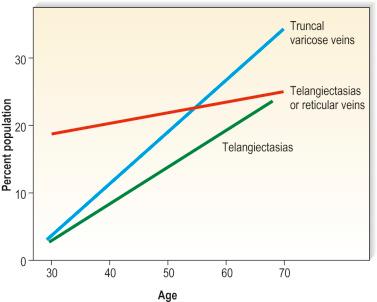
Varicosities in childhood are rare, occurring almost exclusively in association with congenital vascular malformations (see Chapter 3 ). When varicosities occur, they usually appear as a subtle physical finding, such as a slight bulge over the popliteal fossa ( Fig. 2.7 ). One estimation on the incidence of telangiectasias in children was performed by Oster and Nielsen in Denmark. Of 2171 Danish schoolchildren examined, 46.2% of the girls and 35.1% of the boys had telangiectasias on the nape of the neck; 1% of these children had pronounced telangiectasias elsewhere; that is, on the shoulders, thorax, cheeks and ears. No mention was made of the occurrence of telangiectasias on the legs. An examination of 403 children in the former East Germany, aged 8 to 18 years, disclosed a 50% incidence of ‘very discrete’ venous abnormalities of leg veins. Of the children examined, 15% had clear symptoms (without visible varices) that could be assigned to a prospective varicose disease. Only between the ages of 17 and 18 years could reticular varicose veins be identified. In the 403 children studied by venous Doppler, 2.3% had incompetent communicating veins and 3.2% had an incompetent saphenofemoral junction. An epidemiologic study of 419 Czechoslovakian children aged 8 to 13 years, with clinical examination plus digital photoplethysmography, showed clinically apparent varices in 8.7% and an impairment of venous function in 14.3% of the examined extremities.
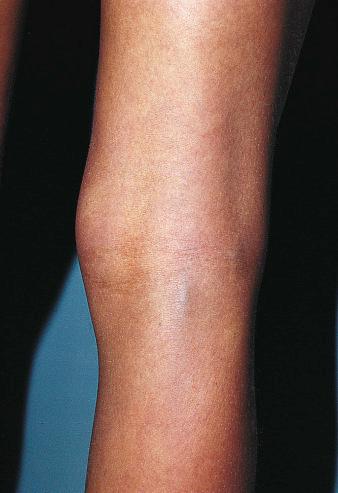
The most recent and complete studies of 518 children aged 10 to 20 years, using photoplethysmography in addition to venous Doppler, are the Bochum I, II and III studies. This continuing investigation initially demonstrated a 10.2% incidence of reticular varicose veins without other venous abnormalities in children who were 10 to 12 years of age. When these children were examined 4 years later, the incidence of reticular veins was 30.3%; 2% of the children had developed varicose veins and 4% had developed incompetent communicating veins. When they were examined another 4 years later, the frequency of saphenous refluxes and large varices was still increasing (19.8% saphenous refluxes, 3.3% truncal varices, 5% tributary varices and 5.2% incompetent perforators). The incidence of reticular veins increased to 35.5%, and the incidence of telangiectasia increased to 12.9%. Therefore, venous disease can be demonstrated in a small number of children, its progression can be documented and saphenous reflux is a risk factor for the development of truncal varices.
Become a Clinical Tree membership for Full access and enjoy Unlimited articles
If you are a member. Log in here